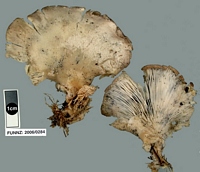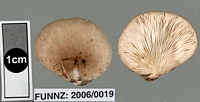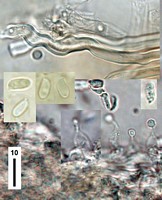|
 Pleurotus djamor Pleurotus djamor
SynonymsPleurotus opuntiae
Agaricus djamor
Agaricus opuntiae
BiostatusPresent in region - Indigenous. Non endemic
Images (click to enlarge)
Caption: FUNNZ: 2006/0284, See public note for more information
Owner: FUNNZ | 
Caption: FUNNZ: 2006/0019, See public note for more information
Owner: FUNNZ | 
Caption: FUNNZ: 2006/0019, See public note for more information
Owner: FUNNZ |  | |
Article: Segedin, B.P.; Buchanan, P.K.; Wilkie, J.P. (1995). Studies in the Agaricales of New Zealand: new species, new records and renamed species of Pleurotus (Pleurotaceae). Australian Systematic Botany 8: 453-482.
Description: Pileus 20-250 X 10-200 mm, often very large, spathulate, flabelliform to dimidiate,
convex to nearly flat when old, solitary or imbricate, nearly white when young,
becoming greyish brown (5C4, K. & W) near margin and pale golden brown near
point of attachment; surface dry, matt, radially finely fibrillose, sometimes
with very fine, appressed squamules towards attachment, drying pale yellowish
brown (5B5, 6, K & W) to grey brown; margin very slightly inrolled to nearly
straight, sometimes lobed, and occasionally split when older. Lamellae decurrent,
not anastomosing, in 4 or 5 (or 6) series, white, becoming cream with age and
handling, narrow (2 mm) in smaller basidiomes, wider (-5 mm) in larger ones,
thin, crowded; margin very finely fimbriate under a lens in fresh state. Stipe
always lateral, usually short 10-20 X 10-20 mm, but sometimes up to 50 mm long,
sometimes lacking, white; surface downy to strigose. Flesh solid, white, thick
(5 mm) in small specimens, thinner in larger ones. Smell slightly fruity, taste
sweet. Spore print deep cream. Spores 8-9.5 X 3.5-4.5 (8.6 X 3.9)µm, Q = 2.2,
oblong-cylindrical, sometimes slightly longer and narrower in older basidiomes,
hyaline, not dextrinoid or amyloid, thin-walled; apiculus distinct but not very
broad. Basidia clavate, 22-25 X 6µm, extending as they mature to 35 µm, with
2-4 very fine sterigmata, collapsing very readily. Cheilocystidia very
variable in shape, but basically of two kinds. The larger are 20-45µm in length,
variable in width (up to 10 µm), hyaline, clavate, pyriform, sphaero-pedunculate
or obclavate, often curved or geniculate, thin-walled, in clusters like incipient
hyphal pegs, scattered along lamellar edge, responsible for the finely fimbriate
edge seen under a lens in young specimens, but collapsing readily with age.
Between the clusters of larger cheilocystidia are small, fusoid cystidia 15-25
X 5-10 µn, lageniform to mucronate, sometimes capitulate apically or with short,
branched, apical protuberances. All cheilocystidia arise from a band of long,
narrow, parallel hyphae running radially along lamellar margin. Pleurocystidia
are difficult to define; some versiform structures present among the basidia
and of the same length could be interpreted as basidioles. Subhymenium a narrow
(20-25 µm wide) zone of short, branched hyphae, cellular to filamentous near
the trama. Trama irregular, with a tendency towards radiate development in older
basidiomes, monomitic at first but becoming quite strongly dimitic, with skeletal
hyphae becoming dominant in older basidiomes. Skeletal hyphae 2-6 nm in diameter,
varying in length up to 1000 µm, terminal in origin, becoming very thick-walled,
slightly contorted to 'arboriform' (Hilber 1982), occasionally producing short,
stumpy side branches. The rest of the trama consists of generative hyphae 3-4
µm in diameter with conspicuous clamp connections, thin-walled at first, becoming
sclerified. Context similar to trama but more loosely interwoven, with many
skeletal hyphae, somewhat straighter than those in trama, mixed with thin-walled
generative hyphae; occasionally a few somewhat contorted oleiferous hyphae are
found. Pileipellis a narrow zone of more or less parallel, narrow (up to 4 µm
in diameter), thin-walled hyphae coloured faintly brown, with clamp connections.
Some erect hyphal endings have very narrow, mucronate tips and some are aggregated
into the small, appressed squamules towards the stipe. Stipe tissues comprising
thin-walled generative hyphae 4-7 µm in diameter and arboriform skeletals 2-4
µm in diameter, very long, thick-walled and aseptate, in approximately equal
proportions. Tomentose covering of stipe, when present, consisting of bundles
of thin-walled, clamped hyphae 3-4 µm in diameter.
Habitat: Primarily on dead Cordyline australis, where it may occur in great abundance
for two or more seasons after the death of the tree. Also recorded on Araucaria
heterophylla (Salisb.) Franco, Corynocarpus laevigatus, Leptospermum
scoparium, Liquidamber styraciflua L. and Rhopalostylis baueri (Hook.
f.) H. Wendi. & Drude var. cheesmanii (Becc. ex Cheeseman) Sykes.
|